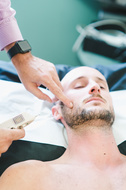
Locals supporters save an additional 5%!
Treatment of Common Lower Body Musculo-Skeletal Conditions Using Electro-acupuncture and Motor points
San Diego, CA 🌝
October 15th and 16th
This seminar covers some of the most common lower body musculoskeletal pain conditions, including proper assessment and treatment using motor points, electro-acupuncture, and soft tissue techniques. You will be able to implement the clinical skills learned in this seminar your first day back in clinic, and experience better results.
Here is what's covered:
A. Foot/Ankle Lecture discussing the relevant anatomy and biomechanical function
•bone, joint, muscle, nerve anatomy of the foot and ankle
•introduction to the fascia of the foot and ankle
•innervation of the fascia and retinacula of the ankle, paratendon and its role in proprioception
•Properties and role of fascia in force absorption and entry point of energy
•Understanding what joint move most during gait (walking) and running
•Learning what accessory movements are and their role in gait and injury along with their effect on the knee, and hip
•Demonstrating manual release and acupuncture treatment using hand positions on an anatomical model of the foot/ankle with prosthetic fascia
•Depth Review of Relevant Clinical Anatomy
•Motor/sensory nerves
•Ligaments, fascia, tendons, joints
•Musculature
•Blood supply
Role of Neurogenic Inflammation
•Review of what is neurogenic inflammation?
•Review of role and time frame of different stages of tissue healing
History/Assessment of Plantar Fascia patients
•ROM
•EXSTORE role
•special testing
•learning history taking
Treatment options and demonstrations of plantar fasciitis
•Electroacupuncture
•Motor point acupucture
•Guasha and manual techniques
B. Classification, Assessment & Treatment of Knee Pain
•Course outline:
What is the difference between traumatic/non-traumatic knee pain?
•pathophysiology
•causes
•risk factors
•anatomy of structures at play
Assessment Protocol
• muscle assessment
• knee/ hip ROM
•orthopaedic testing
Elemental Breakdown of Treatment Protocol
Manual
•guasha application
•manual release
•cutaneous nerve release
Electroacupuncture
•motor points
•Perfusion treatment T10-L2
Patient examples
•Assessment
•Treatment Protocol
•Subsequent Treatments
C. Assessment & Treatment of Hip Pain
•What is an osteoarthritic hip?
•pathophysiology
•causes
•risk factors
•anatomy of structures at play
Assessment Protocol
•meralgia paresthetica
• muscle assessment
•hip ROM
•orthopaedic testing
Elemental Breakdown of Treatment Protocol
Manual
•guasha application
•manual release
•cutaneous nerve release
Electroacupuncture
•motor points
•Perfusion treatment T10-L2
Patient example
•Assessment
•Treatment Protocol
•Subsequent Treatments
D. Assessment and Treatment Low Back Pain
Review of Anatomy and Function
How do you perform an assessment on acute low back pain?
•What are your clinical goals based on your assessment?
•How do determine acupuncture point selection when planning patient treatment?
•What are the different treatment approaches to addressing acute low back pain with electroacupuncture?
Demo: Assessment & Treatment of Acute Low Back Pain Patient
•How to provide an acute low back pain assessment
•Demonstration of acupuncture point selection and treatment of acute low back pain using motor points, the pointer plus, and electro stimulators.
Becoming Familiar With Radicular (Sciatica)Low Back Pain
•What are the causes and physiological mechanisms
•When it is considered a clinical emergency
•Assessment on radicular low back pain
•What are your clinical goals based on assessment
•Determining acupuncture point selection when planning patient treatment
•Different treatment approaches to addressing radicular low back pain with electroacupuncture
Demo: Assessment & Treatment of Radicular (Sciatica)Low Back Pain Patient
E. Assessment & Treatment of Sacroiliac Joint Dysfunction
•What is Sacroiliac Joint Dysfunction
•pathophysiology
•causes
•risk factors
•anatomy of structures at play
•Assessment Protocol of Sacroiliac Joint
•Elemental Breakdown of Treatment Protocol
-Electro-acupuncture
-Manual Work/ Exercises
LIVE Patient(s) Example
•Assessment
•Treatment Protocol
•Subsequent Treatments
F. Assessment & Treatment of Lumbar Spinal Stenosis
Anatomy & Biomechanics of the lumbar spine
-vertebral joint
-zygapophyseal joints
-intervertebral foramen & spinal nerves/vasculature
-key musculature
Pathogenesis of Lumbar Stenosis
-causes
-process of pathology/arthritis
-mechanics
Neurogenic Claudication vs Vascular Claudication
-causes
-process of pathology
-differentiation
Assessment & Treatment of Lumbar Spinal Stenosis
-visual inspection, physical assessment, radiology
-medium to high frequency electroacupuncture based on research
-adjunctive exercises
-manual soft tissue techniques
NEW CONTENT for this seminar has been added!
✅ In depth gait analysis
✅ Functional analysis of the following joints involved in locomotion: 1st MTP,
✅ ankle joint, knee joint, hip joint, sacroiliac joint, lumbosacral joint
✅ Needling protocols to increase ROM in the above joints.
✅ Analysis of foot arches and their effect on knee, hip, and low back pain.
Pre-requisite: You need to have completed the on-line EXSTORE course or attended an EXSTORE live seminar.
Register here:
Give this a read after you watch the video: https://pmc.ncbi.nlm.nih.gov/articles/PMC7689775/
Athletic Intensive Myofascial Release
Location: Shokunin CrossFit, Mesa, AZ
Pre-requisite: EXSTORE
Register here:
https://aseseminars.com/event/athletic-intensive-myofascial-seminar/
Is anyone practicing in area code 23062 - Virginia, or thereabouts? Williamsburg? For a friend with scoliosis and arthritis. thanks in advance.
Patient: 34-year-old female, currently 15 weeks pregnant.
Diagnosis: Ehlers–Danlos syndrome (diagnosed 2021), hypermobility type (hEDS).
Surgical history: Four right hip surgeries between 2021–2024 for a torn labrum, ultimately requiring a cadaver graft, as well as repair of a femoral head injury. All four procedures have been deemed unsuccessful. In 2022, she also underwent shoulder surgery for a labral tear.
EXSTORE findings: Weakness noted in the L gluteus maximus, R adductor magnus, R hip flexors, L serratus anterior, and supraspinatus.
Current symptoms: Significant discomfort localized to the R greater trochanter, adductors, and hamstrings, with associated low back pain.
Pain management history: Prior to pregnancy, symptoms were managed with Baclofen, which was discontinued during pregnancy and is planned to resume postpartum. She claims she has had relief from DN in the past.
My understanding is that Ehlers–Danlos syndrome is an umbrella term encompassing 13 connective tissue ...
Athlete with sub-acute second metatarsal stress fracture currently using rest and laser therapy for treatment. For electroacupuncture... Osteopuncture at 100 Hz at the base and head of the metatarsal to cross the fracture ? 30 Hz across the ankle joint at GB 40 and above the sustentaculum tali? Are MPs relevant here?
















